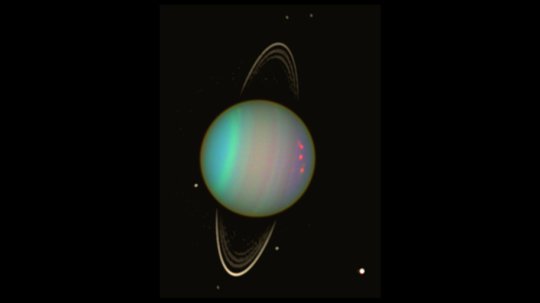Rob Chancia, a University of Idaho doctoral student, identified key designs in the rings while analysing decades – old images of Uranus’s icy rings taken by Voyager 2 in 1986. He identified the volume of ring substance on the edge of the alpha ring – ranging periodically. A similar, even more, lucrative pattern occurred in the similar part of the neighbouring beta ring.

“When you look at this design in distinct places around the ring, the wavelength is distinct – that directs to something altering as you go around the ring. There is something contradicting the symmetry,” says Matt Hedman, an assistant lecturer of physics at the University of Idaho who performed with Chancia to identify the finding.
Hedman and Chancia are well-trained in the physics of planetary rings – both study the rings of Saturn utilizing the data from NASA’s Cassini spacecraft that is presently revolving Saturn. Information from Cassini has introduced novel ideas about how rings act, and a grant from NASA enabled Hedman and Chanciato analyse Uranus information accumulated by Voyager 2 in a novel light. Particularly, they examined radio occultation – prepared when Voyager 2 transferred radio waves through the rings to be identified back on Earth – and stellar occultation, created when the spacecraft estimated the light of background stars glittering through the rings that helps disclose how much substance they include.
They identified the pattern in rings of Uranus which was similar to moon – associated structures in Saturn’s rings known as moonlet waves. The scientists estimate the hypothesized moonlets in Uranus rings would be 2 to 9 miles in diameter – as tiny as some identified moons of Saturn, but smaller than any of Uranus known moons. Such moons are especially difficult to identify as their surfaces are covered in dark substance.
“We have not witnessed the moons yet, but the idea is the dimension of the moons required to prepare such features is quite small, and they could have conveniently been missed,” says Hedman. “The Voyager images were not efficient enough to conveniently see such moons.”
Hedman stated their findings could assist explain some features of Uranus rings, which are narrow in comparison to Saturn. The moonlets, if they exist, may be functioning as ‘shepherd’ moons, supporting to keep the rings from spreading out. Two of Uranus 27 moons, Cordella and Ophella, function as shepherds to epsilon rings of Uranus.
Conclusion
Voyager 2 and its duplicate Voyager 1, were launched 16 days apart in 1977. Both these spacecraft flew by Saturn, and Jupiter and Voyager also flew by Neptune and Uranus. Voyager 2 is the lengthiest regularly operated spacecraft. It is believed to enter interstellar space in coming years, linking Voyager 1.
Filed Under: News


Questions related to this article?
👉Ask and discuss on Electro-Tech-Online.com and EDAboard.com forums.
Tell Us What You Think!!
You must be logged in to post a comment.